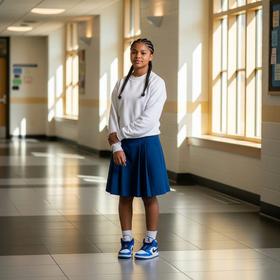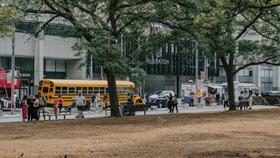Serving 519 students in grades Kindergarten-6, Jay Shideler Elementary School ranks in the top 10% of all schools in Kansas for overall test scores (math proficiency is top 10%, and reading proficiency is top 10%).
The percentage of students achieving proficiency in math is 58% (which is higher than the Kansas state average of 31%). The percentage of students achieving proficiency in reading/language arts is 54% (which is higher than the Kansas state average of 32%).
The student-teacher ratio of 13:1 is equal to the Kansas state level of 13:1.
Minority enrollment is 20% of the student body (majority Hispanic), which is lower than the Kansas state average of 39% (majority Hispanic).
Quick Facts (2025-26)
- Grades: Kindergarten-6
- Enrollment: 519 students
- Student-Teacher Ratio: 13:1
- Minority Enrollment: 20%
- Overall Testing Rank: Top 10% in KS
- Math Proficiency: 58% (Top 10%)
- Reading Proficiency: 54% (Top 10%)
- Science Proficiency: 55-59% (Top 10%)
- Source: National Center for Education Statistics (NCES), KS Dept. of Education
Top Rankings
Jay Shideler Elementary School ranks among the top 20% of public schools in Kansas for:
Category
Attribute
Overall Rank
Math Proficiency
Reading/Language Arts Proficiency
Science Proficiency
School Overview
Jay Shideler Elementary School's student population of 519 students has declined by 7% over five school years.
The teacher population of 41 teachers has grown by 13% over five school years.
Grades Offered
Grades Kindergarten-6
(No virtual instruction)
(No virtual instruction)
Total Students
519 students
Gender %
Total Classroom Teachers
41 teachers
School Calendar
School Rankings
Jay Shideler Elementary School ranks within the top 10% of all 1,269 schools in Kansas (based off of combined math and reading proficiency testing data).
The diversity score of Jay Shideler Elementary School is 0.35, which is less than the diversity score at state average of 0.57. The school's diversity has stayed relatively flat over five school years.
Overall Testing Rank
#100 out of 1269 schools
(Top 10%)
(Top 10%)
Math Test Scores (% Proficient)
58%
31%
Reading/Language Arts Test Scores (% Proficient)
54%
32%
Science Test Scores (% Proficient)
55-59%
31%
Student-Teacher Ratio
13:1
13:1
American Indian
n/a
1%
Asian
3%
3%
Hispanic
8%
22%
Black
2%
7%
White
80%
61%
Hawaiian
n/a
n/a
Two or more races
7%
6%
All Ethnic Groups
Participates in the National School Lunch Program (NSLP)
Yes
Eligible for Free Lunch
13%
42%
Eligible for Reduced Lunch
3%
7%
School Statewide Testing
School District Name
Source: National Center for Education Statistics (NCES), KS Dept. of Education
Profile last updated: 02/09/2025
Frequently Asked Questions
What is Jay Shideler Elementary School's ranking?
Jay Shideler Elementary School is ranked #100 out of 1,269 schools, which ranks it among the top 10% of public schools in Kansas.
What schools are Jay Shideler Elementary School often compared to?
Jay Shideler Elementary Schoolis often viewed alongside schools like Farley Elementary School, Jardine Elementary School by visitors of our site.
What percent of students have achieved state testing proficiency in math and reading?
58% of students have achieved math proficiency (compared to the 31% KS state average), while 54% of students have achieved reading proficiency (compared to the 32% KS state average).
How many students attend Jay Shideler Elementary School?
519 students attend Jay Shideler Elementary School.
What is the racial composition of the student body?
80% of Jay Shideler Elementary School students are White, 8% of students are Hispanic, 7% of students are Two or more races, 3% of students are Asian, and 2% of students are Black.
What is the student-teacher ratio of Jay Shideler Elementary School?
Jay Shideler Elementary School has a student ration of 13:1, which is equal to the Kansas state average of 13:1.
What grades does Jay Shideler Elementary School offer ?
Jay Shideler Elementary School offers enrollment in grades Kindergarten-6 (No virtual instruction).
What school district is Jay Shideler Elementary School part of?
Jay Shideler Elementary School is part of Auburn-Washburn School District.
School Reviews
Review Jay Shideler Elementary School. Reviews should be a few sentences in length. Please include any comments on:
- Quality of academic programs, teachers, and facilities
- Availability of music, art, sports and other extracurricular activities
Recent Articles

How School Zoning Shapes Property Values and School Quality
Learn how school zoning affects property values and public school quality, plus 2025 insights for families evaluating neighborhoods.

Equity and Access in Public Schools in 2025
Explore how equity and access in public schools shape opportunity gaps and what districts can do to address disparities.

Special Education Services in Public Schools, Rights and Resources
Learn how special education services in public schools work, student rights, evaluations, IEPs, and parent resources for 2025.





